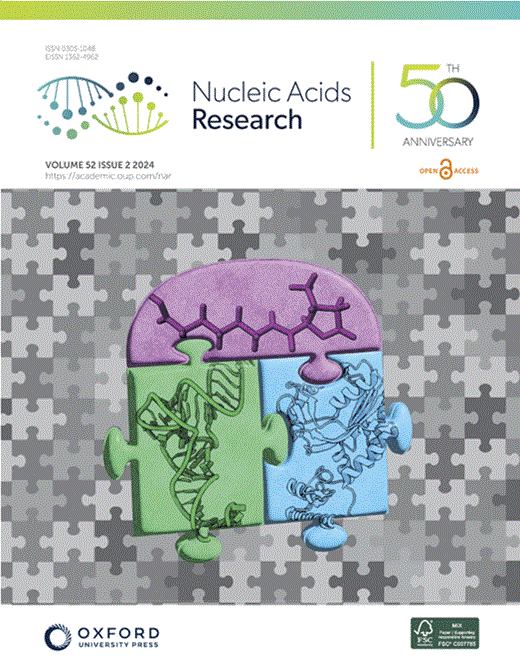逆转录病毒适配器以依赖于CRM1/ xpo1的方式劫持RNA解旋酶UPF1,并揭示了UPF1的前体细胞作用
IF 16.6
2区 生物学
Q1 BIOCHEMISTRY & MOLECULAR BIOLOGY
引用次数: 0
摘要
劫持CRM1输出是逆转录病毒复制周期的一个重要步骤。在这里,我们研究了这种劫持对主机的影响。在HTLV-1感染期间,我们发现病毒蛋白Rex的劫持有利于CRM1和RNA解旋酶UPF1之间的关联,导致UPF1对细胞RNA及其核保留的亲和力降低。结果,我们发现具有抗病毒功能的无义介导的mRNA衰变(NMD)被抑制。为了证实这些结果,我们用HIV-1中Rex的功能同源物Rev描述了类似的过程。出乎意料的是,我们还发现,对于HTLV-1,这一过程与UPF1特异性加载到vRNA相结合,独立于NMD。在后一种情况下,UPF1积极调节病毒复制周期的几个步骤,从vRNA的核输出到成熟病毒颗粒的产生。本文章由计算机程序翻译,如有差异,请以英文原文为准。
Retroviral adapters hijack the RNA helicase UPF1 in a CRM1/XPO1-dependent manner and reveal proviral roles of UPF1
The hijacking of CRM1 export is an important step of the retroviral replication cycle. Here, we investigated the consequences of this hijacking for the host. During HTLV-1 infection, we identified that this hijacking by the viral protein Rex favours the association between CRM1 and the RNA helicase UPF1, leading to a decreased affinity of UPF1 for cellular RNA and its nuclear retention. As a consequence, we found that the nonsense-mediated mRNA decay (NMD), known to have an antiviral function, was inhibited. Corroborating these results, we described a similar process with Rev, the functional homolog of Rex from HIV-1. Unexpectedly, we also found that, for HTLV-1, this process is coupled with the specific loading of UPF1 onto vRNA, independently of NMD. In this latter context, UPF1 positively regulates several steps of the viral replication cycle, from the nuclear export of vRNA to the production of mature viral particles.
求助全文
通过发布文献求助,成功后即可免费获取论文全文。
去求助
来源期刊

Nucleic Acids Research
生物-生化与分子生物学
CiteScore
27.10
自引率
4.70%
发文量
1057
审稿时长
2 months
期刊介绍:
Nucleic Acids Research (NAR) is a scientific journal that publishes research on various aspects of nucleic acids and proteins involved in nucleic acid metabolism and interactions. It covers areas such as chemistry and synthetic biology, computational biology, gene regulation, chromatin and epigenetics, genome integrity, repair and replication, genomics, molecular biology, nucleic acid enzymes, RNA, and structural biology. The journal also includes a Survey and Summary section for brief reviews. Additionally, each year, the first issue is dedicated to biological databases, and an issue in July focuses on web-based software resources for the biological community. Nucleic Acids Research is indexed by several services including Abstracts on Hygiene and Communicable Diseases, Animal Breeding Abstracts, Agricultural Engineering Abstracts, Agbiotech News and Information, BIOSIS Previews, CAB Abstracts, and EMBASE.
 求助内容:
求助内容: 应助结果提醒方式:
应助结果提醒方式:


